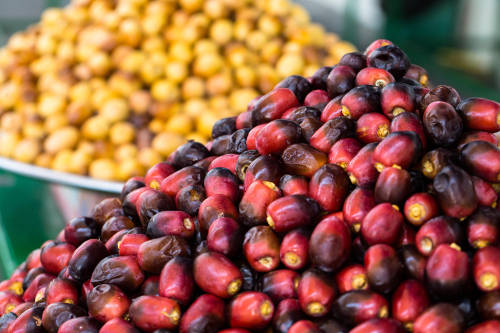Using AI to control energy for indoor agriculture
30 September 2024
Published online 16 November 2015
Gene sequencing unveils the secrets and history of date palms.

© Matthew Corcoran NYU Abu Dhabi
Now, a team of scientists has found the genetic mutation responsible for the red or yellow colour of the sugary date fruit and linked date palms with their distant cousin the oil palm, separated by 60 million years of evolution.
“The colour variation gene …has been mapped in oil palm, so we used a candidate gene approach by mapping its orthologue in date palm. This tells us that the colour trait evolved in parallel in the two species,” says Khaled Hazzouri, a geneticist at New York University Abu Dhabi (NYUAD).
The discovery is part of the ongoing 100 dates! gene sequencing project at NYUAD. Thanks to a three-year collaboration between researchers in the United Arab Emirates, Iraq, Syria, Tunisia, Qatar, Pakistan and the US, the team at NYUAD has analysed the genomic sequence of 62 varieties of date palms from 12 countries across the Middle East, North Africa and South Asia.
Their work, published in Nature Communications, provides the first comprehensive catalogue of molecular variation in date palms and identifies more than seven million genetic mutations. As well as fruit colour, the team has also found genes that may be important in fruit quality, ripening and disease resistance.
“We hope that some of these genomic technologies will allow people to think of creating ways to accelerate breeding processes in date palms that can be useful for the future,” says Michael Purugganan, co-director of the Centre for Genomics and Systems Biology at NYUAD, who is leading the 100 dates! project.
Genetic information could be used to identify date varieties that can handle the challenges of climate change such as rising temperatures, reduced water supply and increased salinity without compromising on the sweetness of the fruit produced, explains Joel Malek from Weill Cornell Medical College in Qatar. “We need that genetic infrastructure in place to be able to answer those questions. Sixty-two genomes is not quite enough – we are hoping to expand to 250. But it’s a great start.”
The team is also interested in how to use genetics to combat pests and diseases, such as the fungal blight, Bayoud disease, which can wipe out entire plantations.
“The identification of mutations in pathways associated with disease resistance, fruit quality, flowering time and sugar metabolism are essential for future breeding of the species,” says Frederique Aberlenc, an independent genetic researcher at the Institut de Recherche pour le Développment, France.
Ajay Kumar Garg, a geneticist at the Khalifa Center for Genetic Engineering and Biotechnology, UAE University, agrees that the study provides valuable insights for the region. “The discovery of novel genes associated with fruit traits or abiotic stress tolerance will help in creating designer date palm varieties that can meet the demands of modern cultivation in the Middle East.”
The study also sheds light on the history of the date palm, whose origin is still obscure. No wild ancestor has yet been discovered and both the Arabian Gulf and parts of North Africa like to claim the fruit tree for their own.
Genetic differences between Middle Eastern and North African date palms show two distinct varieties of the tree. There are two possible explanations for this: either domestication took place separately at different times, or date palms were first cultivated in the Middle East, then spread to North Africa where they were crossed subsequently with a wild North African predecessor.
The analysis, Aberlenc says, confirms previous research suggesting the existence of two date palm populations. The higher genetic diversity revealed in the study between western than eastern palms corroborates the hypothesis of two domestication events.
doi:10.1038/nmiddleeast.2015.223
Hazzouri K. et al. Whole genome re-sequencing of date palms yields insights into diversification of a fruit tree crop. Nature Communications http://dx.doi.org/10.1038/ncomms9824 (2015)
Malek, J. et al. De novo genome sequencing and comparative genomics of date palm (Phoenix dactylifera). Nature Biotechnology http://dx.doi.org/10.1038/nbt.1860 (2011)
Singh R. et al. The oil palm VIRESCENS gene controls fruit colour and encodes an R2R3-MYB. Nature Communications http://dx.doi.org//10.1038/ncomms5106 (2015)
Stay connected: